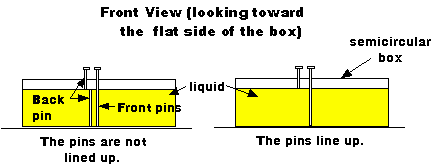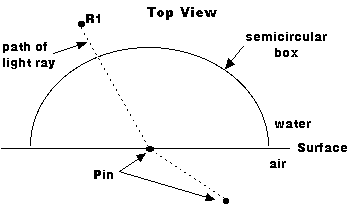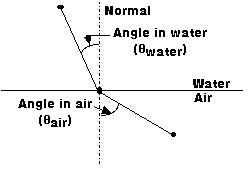Physics Experiment
The Refraction of Light
![[Up]](../../../NavIcons/Up.GIF)
![[Home]](../../../NavIcons/Home.GIF)
![[Help]](../../../NavIcons/Help.GIF)
Questions:
- When light refracts when passing from one medium to another,
how is the angle of incidence related to the angle of
refraction?
- Does light refract at different angles in different
substances?
Discussion:
You know that light, when passing from one medium to another, will
refract or bend. It bends toward the normal line if the light
slows down in the new medium, and it bends away from the normal if it
speeds up in the new medium. But how is the angle of refraction
related to the angle of incidence? In this experiment you will
attempt to answer this question by measuring the angles of incidence
and refraction for light passing from air into water and into other
transparent materials such as glycerine, oil, alcohol, and glass. You
will use the ray-tracing method that you learned when locating images
in plane mirrors.
Scientists often prefer to summarize the results of experiments in
the form of a graph, rather than just present the results as a large
table of numbers. A graph often helps a person to visualize the
relationships among the data. If you use your data from this
experiment to construct a graph of angle of incidence vs. angle of
refraction for water, you could later use the graph to easily predict
the angle of refraction for other situations by interpolation.
Equipment and Materials:
|
semi-circular plastic box
|
3 pins
|
cardboard
|
|
water
|
oil
|
glass semicircle
|
|
straightedge
|
protractor
|
|
Procedure:
- With a straightedge, draw a line across the middle of a sheet
of paper. Label this line "surface". Label one side of the line
"water" (if you are going to use water...) and the other side
"air". Place the paper on the cardboard.
- Fill the semi-circular box with water. (You may use a glass
semicircle instead, or some other liquid.) Dry the outside of the
box and place it on the paper so that its flat side is on the
"surface" line and the curved side lies on the "water" side of the
paper.
- Stick one pin vertically into the paper on the "surface" line
at the middle of the flat side of the box. If the box has a clear
vertical line marked at this position, the pin may not be needed.
This location is where the light ray enters the box. During the
experiment, it is important that you do not move the box or this
pin!
- Stick a second pin into your paper a few centimeters from the
first pin, but still on the side of the paper towards the flat
side of the box. Label this pin "I1" (incidence #1). These 2 pins
determine the path of a light ray that enters the flat side of the
box.

- Now, move to the curved side of the plastic box. Looking
through the liquid in the box, align your eye so that you see
the two pins on the other side of the box in line with each other.
Place the last pin several centimeters from the curved side of the
box, so that it appears to line up with the other 2 pins as you
look through the liquid. Label this pin "R1" (refraction #1).
Since the light will only refract at the flat side of the box
(Why?), the three pins you have placed trace a light ray from the
air through the water.

- Go back to step 4 and move your "incidence" pin to a new
location on the flat side of the box to produce a new angle of
incidence. Do not move the pin on the "surface" line. Then
repeat step 5 to locate the "refraction" pin for this angle. Label
these pins "I2" and "R2" respectively. Continue in this manner
until you have gathered data over as wide a range of angles as
possible. You want to have both small, large, and intermediate
angles represented in your data. Try to have at least 15 data
points for each substance.
- When you have finished taking data for water (or whatever
substance you used for the first set of trials), get some other
transparent liquid or a solid glass semicircle. Repeat steps 1-6
for this substance.
Results:
- Create a data table for each substance that you examined in
your experiment. Although there is an angle of incidence and an
angle of refraction, it is usually more convenient to talk about
the "angle in air" or the "angle in water" instead. Make 3 columns
and label them "Trial", "Angle in air, qair
(o)", and "Angle in water, qwater
(o)". Here, the "q" is the Greek letter
"theta", which is commonly used to represent angles. Hopefully I
don't have to mention that if you are using glass instead of
water, you label the columns
qglass, or whatever...

- On your data sheet, carefully draw and label a normal
(perpendicular) to the surface through the center pin
location.
- Carefully draw and measure each angle in air and angle in the
other substance and place the numbers in the data table.
- Construct a graph of "Angle in Air" vs. "Angle in Water" (or
whatever) for each substance. Put the angle in air on the
horizontal axis. Use an entire sheet of graph paper for each
graph, and make the graph as large as is reasonable convenient.
You may be able to plot the graph of both substances on the same
graph, but if you do use different colors (or something) to
indicate which substance each point belongs to. Be sure to label
the axes and title the graph - don't forget to indicate which
substance is which on the graph.
- Draw the BEST SMOOTH CURVE through the data points. (This
curve may not be a straight line...)
Conclusions:
Write a short paragraph summarizing your results in this
experiment.
References:
Haber-Schaim, et. al., PSSC Laboratory Guide, 4th Edition,
p. 5
Genzer, Laboratory Investigations in Physics, p. 167
![[Up]](../../../NavIcons/Up.GIF)
![[Home]](../../../NavIcons/Home.GIF)
![[Help]](../../../NavIcons/Help.GIF)
last update November 24, 1998 by JL
Stanbrough